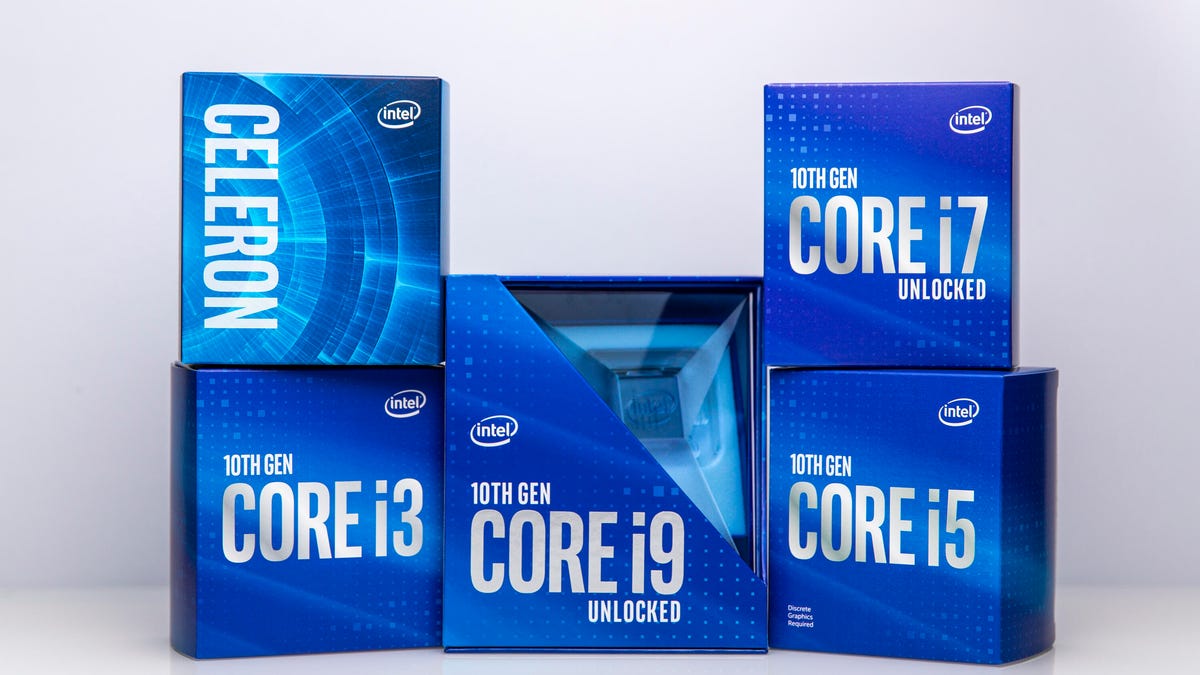Intel Core i9-10900K edges up to 5.3GHz, 10 cores for gaming desktops
Overclockers, start your engines.

Intel on Thursday led its annual deluge of new consumer desktop processors with a speed demon intended to bliss out overclockers who've been stockpiling liquid nitrogen along with toilet paper. The 10-core Core i9-10900K, with its claimed peak single-core frequency of 5.3GHz, tops this year's 10th-gen range, which is based around Intel's 14nm Comet Lake-S architecture.
The rest of Intel's new lineup is business as usual, with some welcome but not Earth-shattering upgrades.
Intel adds Turbo Boost Max 3.0 technology, which debuted with the more creative-focused, higher-core-count 10th-gen X series CPUs. It's adding Thermal Velocity Boost, which launched in the recent 10th-gen i9 mobile processors, to the i9. The i7 gets only the Turbo Boost 3.0 boost.
Turbo Boost Max 3.0 lets the system selectively speed up the two best-performing cores in the processor, while Thermal Velocity Boost will increase core frequencies if there's enough cooling headroom to allow it. (That's assuming the manufacturer has provided the appropriate up-frequency policies in the BIOS.) Combining those two new technologies helps Intel achieve that 5.3GHz single-core frequency claim.
The Core i9 and i7 now max out with 2,933MHz DDR4 memory, which should help improve their performance as well. Everything else on the line remains at 2,667MHz.
There are enhancements across the entire Core line that promise a reasonable uptick in performance at all levels. Intel has brought hyperthreading back to the i7 and lower parts. It dropped the capability, which allows each core to be split into two logical processors for improved parallel processing, for the ninth-gen versions of those CPUs (the ninth-gen i9 parts kept it). In other words, the 10th-gen i7 is still an eight-core processor and the i5 still has six cores, but now they support 16 or 12 threads, respectively. And so on, down the line.
This, plus the adoption of a thinner die -- the actual computing guts -- combined with a thicker layer of the solder thermal-interface material should improve heat dissipation. Less heat means higher sustained speeds for longer periods.
They also get a bump in the maximum number of PCIe 3.0 lanes (up to 40 from 16) as well as Wi-Fi 6 AX201 and 2.5G Ethernet support. All of those depend on the motherboard configuration, however, so don't assume a system you buy will automatically include the capabilities.
For K series processors, Intel has updated its Extreme Tuning Utility with more granular options. These include the ability to toggle hyperthreading on and off on a per-core basis and improved controls over voltage and frequency curves.
Because these processors are based on a refresh of the older Comet Lake generation, Thunderbolt 3 support still resides in an optional external chipset. By comparison, the Ice Lake mobile CPUs which have Thunderbolt 3 support built in. Without Thunderbolt 3 (or still-on-the-horizon USB 4.0) for fast file transfer and no upgrade to PCI 4.0 for higher internal bandwidth when compatible components ship, it's hard to get excited about these as an investment in a system you'll likely have for at least three years.
It's doubly disappointing that the more mainstream parts, especially the T series (because it will likely end up in all-in-ones without discrete graphics), stick with the long-in-the-tooth integrated UHD Graphics 630. I'd have liked to see Intel up them to the better (but still old) Iris Pro graphics, which have made their way into the Ice Lake processors.
I wouldn't expect any huge improvements over the ninth-gen models for most of the processors going into systems for the bulk of PC buyers: Models based around the Core i5 or i3 that typically cost less than $1,000.
10th-gen Intel Core mainstream CPUs
| Processor | Cores/threads | Base clock (GHz) | Max boost (single core/all cores, GHz) | TDP (watts) |
|---|---|---|---|---|
| i3-10100T | 4/8 | 3.6 | 3.8/3.5 | 35 |
| i3-10300 | 4/8 | 3.7 | 4.4/4.2 | 65 |
| i3-10300T | 4/8 | 3.0 | 3.9/3.6 | 35 |
| i5-10400 | 6/12 | 2.9 | 4.3/4.0 | 65 |
| i5-10400T | 6/12 | 2.9 | 3.6/3.2 | 35 |
| i5-10500 | 6/12 | 3.1 | 4.54.2 | 65 |
| i5-10500T | 6/12 | 3.1 | 3.8/3.5 | 35 |
| i5-10600 | 6/12 | 3.3 | 4.8/4.4 | 65 |
| i5-10600K | 6/12 | 4.1 | 4.8/4.5 | 125 |
| i5-10600T | 6/12 | 2.4 | 4.0/3.7 | 35 |
| i7-10700 | 8/16 | 2.9 | 4.8/4.6 | 65 |
| i7-10700K | 8/16 | 3.8 | 5.1/4.7 | 125 |
| i7-10700T | 8/16 | 2.0 | 4.5/3.7 | 35 |
| i9-10900 | 10/20 | 2.8 | 5.2/4.6 | 65 |
| i9-10900K | 10/20 | 3.7 | 5.3/4.9 | 125 |
| i9-10900T | 10/20 | 1.9 | 4.6/3.7 | 35 |
Note: The i9-10900 series peak core frequencies are obtained with Intel's Thermal Velocity Boost. TDP (thermal design power) defines the type of system the chip is intended for: 125 watts tends to be big desktops (overclockable K series processors), 65 watts are mainstream and 35 watts are compact or all-in-one "lifestyle" systems (T series). There are also F versions of the i9, i7 and i5, which punt the integrated graphics but are otherwise identical to the standard version.

